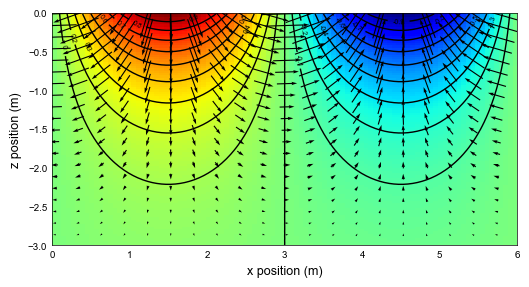This page was generated from
ex-gwf-spbc.py.
It's also available as a notebook.
SPBC example
Periodic boundary condition problem is based on Laattoe and others (2014). A MODFLOW 6 GWF-GWF Exchange is used to connect the left column with the right column.
Initial setup
Import dependencies, define the example name and workspace, and read settings from environment variables.
[1]:
import os
import pathlib as pl
import flopy
import git
import matplotlib.pyplot as plt
import numpy as np
from flopy.plot.styles import styles
from modflow_devtools.misc import get_env, timed
# Example name and workspace paths. If this example is running
# in the git repository, use the folder structure described in
# the README. Otherwise just use the current working directory.
sim_name = "ex-gwf-spbc"
try:
root = pl.Path(git.Repo(".", search_parent_directories=True).working_dir)
except:
root = None
workspace = root / "examples" if root else pl.Path.cwd()
figs_path = root / "figures" if root else pl.Path.cwd()
# Settings from environment variables
write = get_env("WRITE", True)
run = get_env("RUN", True)
plot = get_env("PLOT", True)
plot_show = get_env("PLOT_SHOW", True)
plot_save = get_env("PLOT_SAVE", True)
Define parameters
Define model units, parameters and other settings.
[2]:
# Model units
length_units = "meters"
time_units = "days"
# Model parameters
nper = 1 # Number of periods
nlay = 190 # Number of layers
ncol = 100 # Number of columns
nrow = 1 # Number of rows
delr = 0.06 # Column width ($m$)
delc = 1.0 # Row width ($m$)
delv = 0.03 # Layer thickness ($m$)
top = 0.0 # Top of the model ($m$)
strt = 0.0 # Starting head ($m$)
icelltype = 0 # Cell conversion type
hydraulic_conductivity = 1.0 # Horizontal hydraulic conductivity ($m/d$)
# Static temporal data used by TDIS file
# Simulation has 1 steady stress period (1 day)
# and 3 transient stress periods (10 days each).
# Each transient stress period has 120 2-hour time steps.
perlen = [1.0]
nstp = [1]
tsmult = [1.0]
tdis_ds = list(zip(perlen, nstp, tsmult))
# assign botm
botm = [top - k * delv for k in range(1, nlay + 1)]
# Solver parameters
nouter = 50
ninner = 100
hclose = 1e-9
rclose = 1e-6
Model setup
Define functions to build models, write input files, and run the simulation.
[3]:
def build_models():
sim_ws = os.path.join(workspace, sim_name)
sim = flopy.mf6.MFSimulation(sim_name=sim_name, sim_ws=sim_ws, exe_name="mf6")
flopy.mf6.ModflowTdis(sim, nper=nper, perioddata=tdis_ds, time_units=time_units)
flopy.mf6.ModflowIms(
sim,
outer_maximum=nouter,
outer_dvclose=hclose,
inner_maximum=ninner,
inner_dvclose=hclose,
rcloserecord=f"{rclose} strict",
)
gwf = flopy.mf6.ModflowGwf(sim, modelname=sim_name, save_flows=True)
flopy.mf6.ModflowGwfdis(
gwf,
length_units=length_units,
nlay=nlay,
nrow=nrow,
ncol=ncol,
delr=delr,
delc=delc,
top=top,
botm=botm,
)
ihc, cl1, cl2, hwva = 1, delr / 2.0, delr / 2.0, delc
angldegx = 90.0
cdist = delr
exgdata = [
[(k, 0, 0), (k, 0, ncol - 1), ihc, cl1, cl2, hwva, angldegx, cdist]
for k in range(nlay)
]
exg = flopy.mf6.ModflowGwfgwf(
sim,
exgtype="GWF6-GWF6",
nexg=len(exgdata),
auxiliary=["ANGLDEGX", "CDIST"],
exgmnamea=sim_name,
exgmnameb=sim_name,
exchangedata=exgdata,
)
flopy.mf6.ModflowGwfnpf(
gwf,
icelltype=icelltype,
k=hydraulic_conductivity,
save_specific_discharge=True,
)
flopy.mf6.ModflowGwfic(gwf, strt=strt)
hm = 1.0
lmbda = ncol * delr
wv = 2 * np.pi / lmbda
x = gwf.modelgrid.xcellcenters
chd_head = hm * np.sin(wv * x)
chd_spd = []
for j in range(ncol):
chd_spd.append([0, 0, j, chd_head[0, j]])
flopy.mf6.ModflowGwfchd(
gwf,
stress_period_data=chd_spd,
pname="CHD",
)
head_filerecord = f"{sim_name}.hds"
budget_filerecord = f"{sim_name}.cbc"
flopy.mf6.ModflowGwfoc(
gwf,
head_filerecord=head_filerecord,
budget_filerecord=budget_filerecord,
saverecord=[("HEAD", "ALL"), ("BUDGET", "ALL")],
)
return sim
def write_models(sim, silent=True):
sim.write_simulation(silent=silent)
@timed
def run_models(sim, silent=False):
success, buff = sim.run_simulation(silent=silent, report=True)
assert success, buff
Plotting results
Define functions to plot model results.
[4]:
# Figure properties
figure_size = (6, 4)
def plot_grid(sim):
with styles.USGSMap():
gwf = sim.get_model(sim_name)
fig = plt.figure(figsize=figure_size)
fig.tight_layout()
# create MODFLOW 6 head object
head = gwf.output.head().get_data()
# create MODFLOW 6 cell-by-cell budget object
qx, qy, qz = flopy.utils.postprocessing.get_specific_discharge(
gwf.output.budget().get_data(text="DATA-SPDIS", totim=1.0)[0],
gwf,
)
ax = fig.add_subplot(1, 1, 1, aspect="equal")
pxs = flopy.plot.PlotCrossSection(model=gwf, ax=ax, line={"row": 0})
# pxs.plot_grid()
pxs.plot_bc(name="CHD")
pxs.plot_array(head, cmap="jet")
levels = np.arange(-1, 1, 0.1)
cs = pxs.contour_array(
head, levels=levels, colors="k", linewidths=1.0, linestyles="-"
)
pxs.plot_vector(qx, qy, qz, normalize=False, kstep=5, hstep=5)
ax.set_xlabel("x position (m)")
ax.set_ylabel("z position (m)")
ax.set_ylim(-3, 0)
styles.remove_edge_ticks(ax)
plt.clabel(cs, fmt="%3.1f", fontsize=5)
if plot_show:
plt.show()
if plot_save:
fpth = figs_path / f"{sim_name}-grid.png"
fig.savefig(fpth)
def plot_results(sim, silent=True):
plot_grid(sim)
Running the example
Define and invoke a function to run the example scenario, then plot results.
[5]:
def scenario(silent=True):
sim = build_models()
if write:
write_models(sim, silent=silent)
if run:
run_models(sim, silent=silent)
if plot:
plot_results(sim, silent=silent)
scenario()
<flopy.mf6.data.mfstructure.MFDataItemStructure object at 0x7f96b7c67b80>
run_models took 205.26 ms
